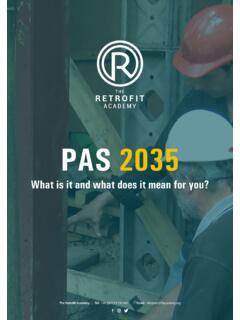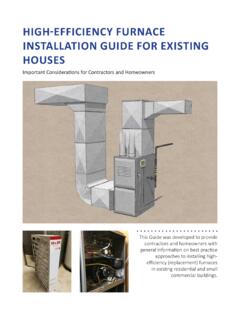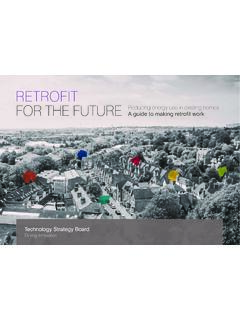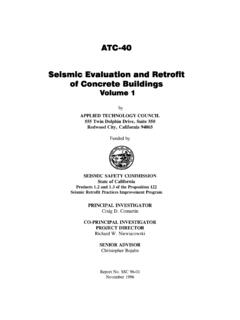Transcription of The Future Homes Standard: 2019 (conservation of fuel and ...
1 January 2021 Ministry of Housing, Communities and Local Government The Future Homes Standard: 2019 Consultation on changes to Part L (conservation of fuel and power) and Part F (ventilation) of the Building Regulations for new dwellings Summary of responses received and Government response Crown copyright, 2021 Copyright in the typographical arrangement rests with the Crown. You may re-use this information (not including logos) free of charge in any format or medium, under the terms of the Open Government Licence. To view this licence visit This document/publication is also available on our website at If you have any enquiries regarding this document/publication, complete the form at or write to us at: Ministry of Housing, Communities and Local Government Fry Building 2 Marsham Street London SW1P 4DF Telephone: 030 3444 0000 For all our latest news and updates follow us on Twitter.
2 January 2021 3 Contents Executive Summary 4 Chapter 1 - Introduction 7 Chapter 2 - The Future Homes Standard 12 Chapter 3 - Part L standards for new Homes in 2021 27 Chapter 4 - Part F Changes for new Homes in 2021 65 Chapter 5 - Airtightness 82 Chapter 6 - Compliance, Performance and Providing Information 91 Chapter 7 - Transitional Arrangements 100 Chapter 8 - Impact Assessment 104 Annex A - Draft notional building specification for the Future Homes Standard 106 Annex B - Notional building specification for Part L 2021 108 Annex C - BREL Compliance Report 111 4 Executive Summary The challenges involved in improving the energy efficiency of our buildings and reducing carbon emissions are not insubstantial.
3 However, new build is an area where we can and must maintain momentum. This document sets out the Government s response to the first stage of a two-part consultation on proposed changes to Part L (Conservation of fuel and power) of the Building Regulations. The consultation contained proposals for changes to the energy efficiency standards for new Homes , as well as the wider impacts of Part L, including changes to Part F (Ventilation), its associated Approved Document guidance, airtightness and improving the as-built performance of the constructed home .
4 Chapter 2 We have said that from 2025, the Future Homes Standard will deliver Homes that are zero-carbon ready We intend to set the performance standard of the Future Homes Standard at a level which means that new Homes will not be built with fossil fuel heating, such as a natural gas boiler. These Homes will be Future -proofed with low carbon heating and high levels of energy efficiency. No further energy efficiency retrofit work will be necessary to enable them to become zero-carbon as the electricity grid continues to decarbonise. Our work on a full technical specification for the Future Homes Standard has been accelerated and we will consult on this in 2023.
5 We also intend to introduce the necessary legislation in 2024, ahead of implementation in 2025. Chapter 2 We acknowledged the need to clarify Local Planning Authorities role in setting energy efficiency requirements for new Homes that go beyond the minimum standards set through the Building Regulations The new planning reforms will clarify the longer-term role of local planning authorities in determining local energy efficiency standards . To provide some certainty in the immediate term, we will not amend the Planning and Energy Act 2008, which means that local authorities will retain powers to set local energy efficiency standards for new Homes .
6 5 Chapter 3 We said that in 2020, we would introduce an interim uplift in Part L standards that delivered a meaningful reduction in carbon emissions and provided a stepping stone to the Future Homes Standard A low carbon heating system will be integral to the specification of the Future Homes Standard and we anticipate that heat pumps will become the primary heating technology for new Homes . We must ensure that all parts of industry are ready to meet the Future Homes Standard from 2025, which will be challenging to deliver in practice, by supporting industry to take a first step towards the new standard.
7 A 2021 interim uplift will deliver high-quality Homes that are in line with our broader housing commitments and encourage Homes that are Future -proofed for the longer-term. These Homes will be expected to produce 31% less CO2 emissions compared to current standards . Chapter 3 We asked if the Fabric Energy Efficiency Standard should be removed as a performance metric for new Homes , to minimise complexity and avoid confusion We have settled on a revised package of performance metrics that will ensure a fabric first approach is at the heart of all new Homes alongside a low carbon heating system.
8 The Fabric Energy Efficiency Standard will be one of four performance metrics that achieves this balance. Chapter 6 We put forward a comprehensive package of measures to improve compliance, reduce the performance gap and provide more information to energy assessors, building control and homeowners We will introduce all of the proposals set out in the consultation to help address the performance gap. This will reduce the performance gap by improving the accuracy of as-built energy calculations and providing clearer information about the as-built specifications of new buildings to both building control bodies and homeowners.
9 Chapter 7 We said that we would introduce more stringent transitional arrangements to ensure as many Homes as possible are being built to new energy efficiency standards Transitional arrangements provide all developers with certainty about the standards they are building to. 6 To ensure as many Homes as possible are being built in line with new energy efficiency standards , transitional arrangements will now apply to individual Homes rather than an entire development and the transitional period will be one year. This approach will support successful implementation of the 2021 interim uplift and therefore better support the wider implementation timeline for the Future Homes Standard from 2025.
10 7 Chapter 1 - Introduction Net zero emissions and climate change The UK was the first major world economy to pass a net zero emissions target into law. This target, which was recommended by the Committee on Climate Change, is one of the most ambitious in the world and requires the UK to bring all greenhouse gas emissions to net zero by In 2018, heating and powering Homes accounted for 22% of all greenhouse gas emissions in the UK. The UK has already made considerable progress in this sector by reducing total emissions by 43% since 1990, despite there being approximately a quarter more The Homes that are constructed now and in the next decade will still exist in 2050 and we have acknowledged that more must be done to decarbonise all The minimum energy efficiency standards that we set for buildings must put us on the right path to achieve our net zero target.

















